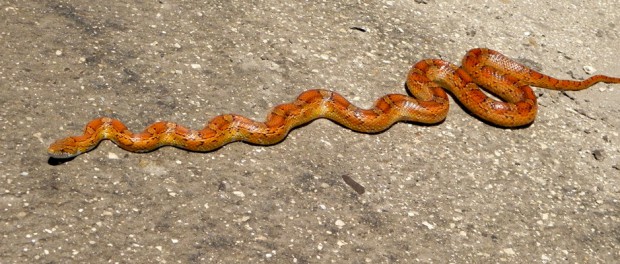http://app.getresponse.com/click.html?x=a62b&lc=LvKLO&mc=IC&s=9yWxmR&u=Yy3s&y=P&

Researchers Confirm Snake Fungal Disease Culprit
By Dana Kobilinsky
Researchers have identified the fungus that’s causing snake fungal disease, an emerging disease in the eastern and midwestern United States that causes lesions on a number of snake species.
While past research has confirmed the fungus Ophidiomyces ophiodiicola in the snakes’ lesions, researchers hadn’t tested whether the fungus is the agent causing the disease. “Just because something is correlated with disease, doesn’t necessarily make it the causative agent,” said Jeffrey Lorch, a microbiologist at the United States Geological Survey National Wildlife Health Center and lead author of the study published in mBio, an open-access journal of the American Society for Microbiology.
Lorch, a member of The Wildlife Society, was able to prove this. With his research team, Lorch took healthy corn snakes (Pantherophis guttatus) bred in captivity and exposed them to the fungus to see if they developed the same clinical and microscopic signs of the disease. After touching fine grain sandpaper to the snakes’ skin to create abrasions, researchers inoculated the fungus onto the snakes’ skin. “We also put it on the animals that didn’t have their skin abraded,” Lorch said. The team also had a control group that wasn’t exposed to the fungus at all.
The snakes with abraded skin were more likely to come down with the infection, Lorch said. In the wild, Lorch said that it probably isn’t uncommon for snakes to develop the small cuts they simulated in the experiment by simply from crawling on the ground. The team found that none of the snakes from the control group contracted the disease, while all of the ones in the experimental group did.
The team was also surprised by some of their observations in the laboratory. They saw snakes that were infected were exposed in certain areas of their cages although there was no basking light or heat gradient. In the wild, snakes have been observed doing similar abnormal behaviors such as basking in winter when they should be hibernating. “It’s interesting that we saw this in the lab, too,” Lorch said. With this knowledge, some biologists have proposed opening forest canopy where some rattlesnake dens are becoming shaded, so the snakes’ get more sun exposure to fight off the infection.
They also found that the snakes exposed to the fungus molted almost twice as frequently as the control group, which was abnormal. They were likely doing this in an attempt to shed the fungus from their skin, Lorch said.
“There was strong evidence before that showed the fungus probably was the cause,” Lorch said. “But we didn’t have complete confirmation. Now that we know, we can focus our attention specifically on that fungus and its interactions with snakes that result in disease progression.”
-------------------------------------------
https://www.google.com/url?sa=t&rct=j&q=&esrc=s&source=web&cd=5&cad=rja&uact=8&ved=0ahUKEwiunbjrp6PJAhUIWx4KHYRqBQcQFgg2MAQ&url=http%3A%2F%2Fwww.natureworldnews.com%2Farticles%2F15719%2F20150719%2Fdeadly-fungus-killing-snakes-leaves-none-alive.htm&usg=AFQjCNEPE1YUBhMtRCTz9yXsm6n7NJMxHQDeadly Fungus is Killing US Snakes, Leaves None Alive
Jul 19, 2015 04:06 AM EDT

(Photo : Pixabay)
It's very rare for a disease to boast a 100 percent mortality rate. Rabies, for instance, is considered thedeadliest disease in the world and even it has seen a handful of exceptionally lucky survivors. However, in the case of a new fungal disease sweeping through North American snakes, experts are reporting only death and more death.
"Reports of fungus on snakes started trickling in a few years ago, and there has been some concern that this represents a new emerging threat," David Stern, a herpetologist at Auburn Universityrecently explained in the University of Washington'sConservation Magazine.
And there is certainly a lot of reason for concern. Fungal diseases have recently been ravaging amphibian populations across half the globe, and while that wouldn't include snakes, it does set a precedent for taking fungal epidemics seriously. (Scroll to read on...)
Scientists actually first started investigating the "snake fungal disease" (SFD), as it's now called, in the early 2000s. Within that time, Florida wildlife officials reported disturbing mass deaths of pygmy rattlesnakes - first a clutch of 42, and later 59 more carcasses.
ADVERTISING
The damage the disease does is brutal and recognizable, with severe skin lesions, swelling, and contortion after an infection reaches the bones of its victims. This allowed experts to quickly catch on to the fact that SFD has already spread to at least 15 states, and affects everything from poisonous rattlers to garter snakes, rat snakes, and even rare ribbon varieties.
When researchers turned their attention to a small population of timber rattlesnakes in New Hampshire displaying these symptoms, they witnessed the disease kill more than 50 percent. The remaining survivors, while having been exposed to the disease, had never become infected themselves. That is to say, every snake that contracted the disease quickly died.
According to a study recently published in the journal Fungal Ecology, the fungus behind SFD survives by eating keratin - the stuff that makes up both human fingernails and snake scales. Normally happily residing in soil, the opportunistic fungus likely attacks snakes just exiting hibernation - a time when their immune system isn't fully revved up, and they have a nice full set of scales for munching on.
"Mortality," the researchers wrote, "appears to be 100 percent."
The concern now is not that the disease is here, but that it's prevalence is being underestimated. As any gardener or outdoorsman will know, snakes are by-nature tough to find in the wilderness. And if they can't be surveyed, how will scientists ever know an epidemic is on hand until it's too late? For now, it seems like we'll just have to wait and see.











No comments:
Post a Comment